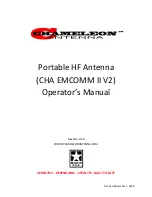
CHA EMCOMM II V2
Page 9
Sloping Wire
The CHA EMCOMM II V2 Sloping Wire configuration, see figure (3), is a broadband short to medium
range HF antenna. It is designed to provide acceptable ground wave and sky wave propagation. This
configuration is predominately omnidirectional, becoming slightly bidirectional towards both ends as
the frequency increases. The Sloping Wire requires one support and should be mounted at a height of
25 to 40 feet for best performance. A counterpoise wire, with a length of 20 - 40 feet, is recommended.
If a counterpoise is not used, the coaxial cable must be 25 to 100 feet in length, as the shield of the
coaxial cable provides the counterpoise.
The “Half Sloper” is a
n alternate version of this configuration,
where the antenna is attached to a metal tower and the antenna is fed from the top.
Figure 3. Sloping Wire Configuration.
Site Selection and Preparation.
1.
Select a site to deploy the CHA EMCOMM II
V2 Sloping Wire configuration. The site
must have a support that will position the
end of the Antenna Wire at a height of 25
to 40 feet. If the right support is
unavailable, any convenient object, such as
a fence post or the top of a vehicle, may be
used as a field expedient support with
reduced performance.
2.
If not already attached, connect a Carabiner
(d) to the Wire Connector (e) end of the
Antenna Wire.
Connect the Matching Transformer. Refer to
plate (3) for steps (3)
–
(5).
3.
Connect the Carabiner from the Antenna
Wire to the Transformer Eyebolt (j).
4.
Connect the Wire Connector from the
Antenna Wire to the Top Transformer
Connection (h). Tighten the wing nut finger
tight.
5.
If using a counterpoise wire, connect it to
the Bottom Transformer Connection (i).
Tighten the wing nut finger tight.
6.
Connect a CHA RFI CHOKE and coaxial cable
or the Integrated RF Choke end of the CHA
Coaxial Cable assembly to the UHF Socket
(g) on the Matching Transformer.
Raise the Antenna.
















